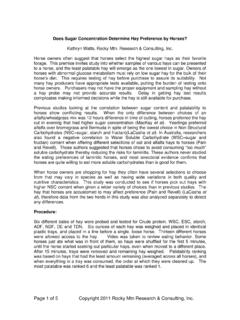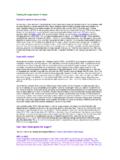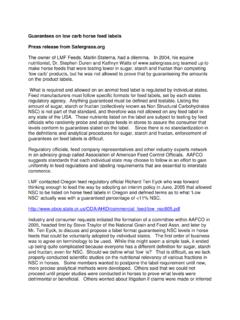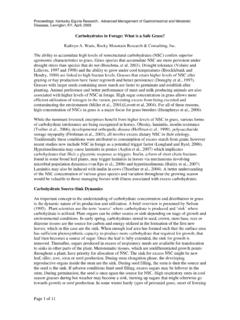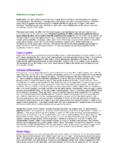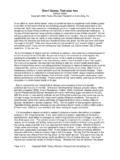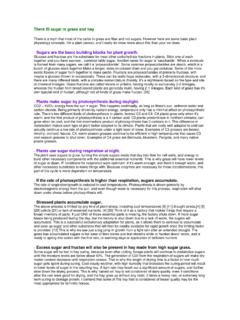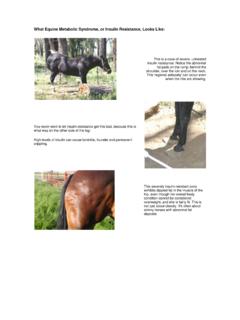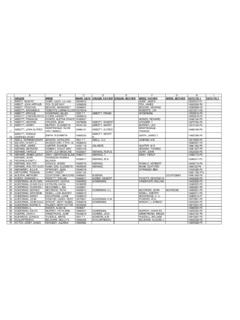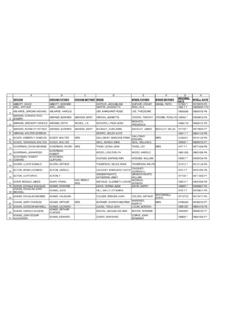Transcription of When is dead grass safe to graze - Katy Watts | …
1 when is dead grass safer to graze ? By kathryn Watts Many of us with laminitic horses look forward to when our pastures die so that we can turn them out longer each day. We have learned that near freezing nights in fall can cause sugars to sky rocket, so horses at high risk for laminitis should be pulled off grass during this time. Winter often means weather and footing that makes riding impossible, so it s even more important for my horses to have a reason to wander about the paddock instead of standing in the run-in shed all day to escape the nasty weather. While my insulin resistant ponies can only eat the improved grass in their paddock for a couple hours during summer, they are able to eat it for 3-4 hours per day by late winter. During fall, when cold nights cause sugar to build up, they are not allowed any access to green grass .
2 All that stockpiled forage that grew in the fall will not go to waste, because once it is completely dead, rain and snow can leach out the accumulated sugars. Many people ask when is it safe to graze ? Like many others things concerning management of laminitic horses, I learned this the hard way. One year in mid December, I turned my ponies out on a grass paddock that was nearly all dead. By the second day, they were sore footed again! Because they were barefoot at the time, I called my farrier, Gene Ovnecik to ask who could come down to put their therapeutic support shoes back on. He told me that his own chronic laminitis cases recently got sore on dead grass . So I asked him to send me some of the grass in a cooler on ice; which I froze as soon as it arrived. I also started sampling some of the dead grass in my research plots.
3 Some of the samples still had some green, living tissue at the stem bases even though it had been below 0 F. Stem bases are a storage organ for sugars in grass , so this will have the highest concentration of sugar. I sent the frozen samples overnight with dry ice to Dairy One for analysis. Any live, green tissue must be kept frozen to preserve the sugar because otherwise the sugar might respire or ferment during shipment, giving you much lower test result, and a false sense of security. The results were quite surprising. This dead grass had some of the highest WSC concentrations I had ever seen. Looks completely dead from the top, but there s a lot of green underneath. Page 1 of 3 Copyright Rocky Mountain Research & Consulting, Inc. Fescue- NSC,Jan. 2004, Center, CO when deciding if dead grass in winter is safe for carbohydrate intolerant horses, make sure you check at the base of the plants.
4 This is the part of the plant that can be extremely high in sugar. If there is still living, green tissue, it may be too early. Wait until the plants are completely dead, and some rain or snow has washed the excess sugars away. Dead grass in mid-winter under drought conditions Testing date NSC Starch WSC sugar+fructan Fescue pasture Dec-21-03 Fescue pasture Jan-07-04 .3 Brome/KBG pasture Dec-15-03 Brome/KBG pasture Jan-04-04 Brome/KBG pasture Feb-21-04 .8 Crest. wheatgrass Jan-01-04 Crest. wheatgrass Feb-23-04 Orchard grass Jan-01-04 Orchard grass Feb-23-04 Tall fescue Jan-01-04 .8 Tall fescue Feb-23-04 Per.
5 Ryegrass Jan-01-04 .7 Per. ryegrass Feb-23-04 .7 Stockpiled forage is a term use for hay that is left standing in the field. In a Canadian study, WSC content of stockpiled grass in April was to 1/3 the concentration the previous October (Baron, 2004). Why was my dead grass so high in sugar? A chat was in order with Dr. Jerry Chatterton, research leader of the USDA-ARS Forage and Rangeland Research Lab. He helped me piece this puzzle together to explain why this almost dead grass was Founder Fodder. That fall was a bit unusual. We were in the midst of a several year long drought. Once we were done sampling the research plots for the year, I stopped irrigating them. We had some terrible wind storms that fall, mixed in with dramatic drops of temperatures below 20F that killed the grass very quickly.
6 The grass was desiccated; looking more like dark green hay than usual brown dead grass . It was freeze dried! That s the perfect way to preserve the sugar in grass . The drought continued though fall and early winter, with no measurable rain. An occasional inch of dry snow evaporated into the cold, dry air without melting. The leaching of sugars that usually occurs for stockpiled forage just didn t happen that year because we had no precipitation. So when Gene Page 2 of 3 Copyright Rocky Mountain Research & Consulting, Inc. and I turned out our high risk ponies on the dead grass , there was still too much sugar left. We both found that later on, after we finally got some wet snow to wash some of the sugar out of the dead tissue, they did fine on the same paddocks. I m more careful now. A vet from Colorado who read an article ( Watts , 2005) that included this data concurred.
7 She was perplexed by horses on dead pasture that winter with classic symptoms of insulin resistance. This data and explanation made perfect sense to her. This year (2007) winter has come early, and the drought has broken. By the end of November, my west paddock was 90% dead and the east paddock was about 50% dead. We had some rain after hard freezes killed off most of the grass , then it got really cold (-0F) and windy and it snowed. I was anxious to turn my bored ponies out for much needed exercise. The first time, I let them out for about 20 minutes, and I watched where they grazed. Sure enough, they went straight to the spots in the paddock where the grass had the most green. Now these 2 ponies are sugar junkies. For years I ve been testing what they choose to eat first, and it s always the highest in sugar compared to the rest of the paddock.
8 To make sure the grass was suitable; I pulled some samples, froze them, and shipped them frozen, overnight to Dairy One. This time I pulled one sample from the greenest spots (about 75% brown, 25% living and green), and another from the brownest spots, which were pretty much completely dead. Fresh grass - Nov. 27, 2007 Dry matter basis StarchWSCESCWest paddock 100% brown West paddock - 25% green paddock - 50% green The east paddock has different species of grass , which have tested slightly lower in NSC than the wpaddock, but as you can see, because it has a lot more green left, it s still too high to allow my insuresistant ponies to have any at all. They do best when NSC (WSC + starch) are less than 10% dm. Water Soluble Carbs will not wash out of grass until iis completely dead and brown.
9 Then you have to have enough rain or melting snow after it s completely dead to leach the sugar out. Until then, please take care with your high risk horses. Proceed with caution, and allow them to acclimate slowly, just as you would if it were June. It might be best to assume that any green grass that has been subjected to repeated freezing nights is candy - full of sugar, even if there is snow on top. If it s still green, the rain/snow cannot leach out the sugar. est lin t Watts , KA, A Review of Unlikely Sources of Excess Carbohydrates in Equine Diets, J. Equine Vet. Sci, 2005, 25(7) p. 338-344 link to full text K. Watts , Dead grass and weeds may contain high levels of non structural carbohydrates. poster, Eq Nut & Phys. Soc., June 2005, Tucson, AZ link to abstract Vern S. Baron, A. Campbell Dick, Myron Bjorge, and Grant Lastiwka (2004) Stockpiling Potential of Perennial Forage Species Adapted to the Canadian Western Prairie Parkland.
10 Agronomy Journal. 96:1545 1552 Page 3 of 3 Copyright Rocky Mountain Research & Consulting, Inc.


